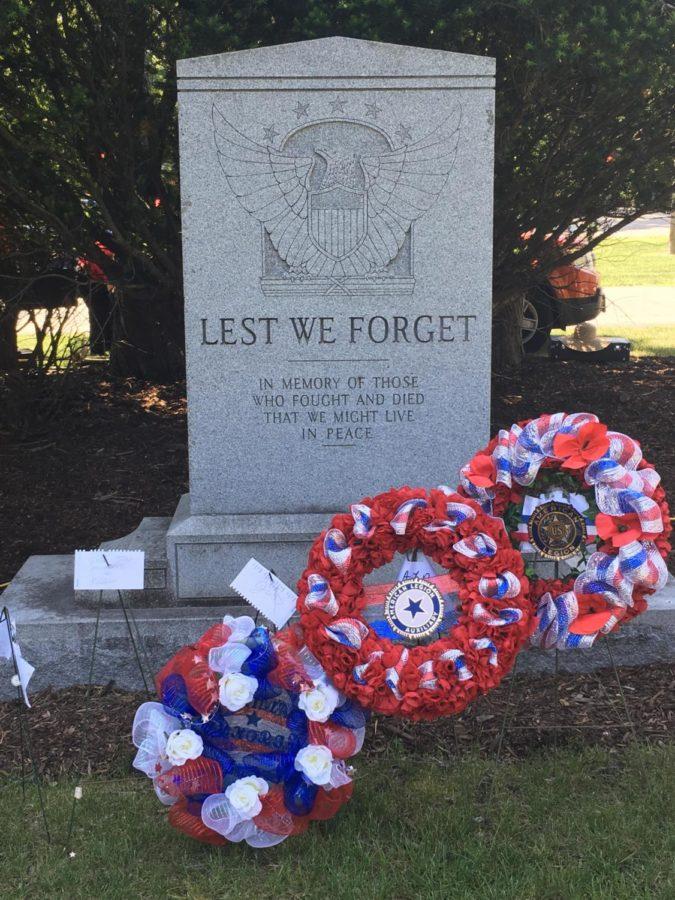- App Content
- App Content / News
- News
- News / Nation
- News / Politics And Administration
- News / Politics And Administration / City
Ames community honors fallen servicemen and women at Memorial Day Parade
Memorial Day Parade ceremony is commemorated with a headstone and wreaths from multiple Ames patriot groups.
May 28, 2018
Flag bearers, veterans and members of the Ames community honored fallen veterans and marched in the Memorial Day parade this morning.
Starting at City Hall, the parade route took marchers to the Ames cemetery, where community members spoke in remembrance of veterans.
“Today we gather together to remember and honor the fallen veterans, who laid down their lives to defend and protect our nation,” said Ames Mayor John Haila. “Heroes are ordinary people with hearts of steel. Their courage, determination and willpower are what make them rise as sentinels of peace and liberty.”
Haila also recognized the families of fallen soldiers who “laid down the ultimate sacrifice” and gave the theme for the program: “Lest We Forget.”
Janet Schmidt, President of the Ames Patriotic Council and Master of Ceremonies, introduced the featured speaker, retired Navy Rear Admiral Kate Gregory.
Gregory said she did not grow up thinking Memorial Day was special.
“I had family in the military, but when Memorial Day came, it was all about playing softball, going to the pool and getting ready for summer,” Gregory said. “This was until I joined the Navy, actually.”
Gregory explained the history behind Memorial Day; it started during the Civil War as a day to decorate gravestones with wreaths and flowers. It wasn’t a national holiday and, until World War I, it only applied to Civil War veterans.
After World War I, Decoration Day started to apply to veterans of all wars. By 1968, Congress made Memorial Day a national holiday. From that point on, Gregory said, the purpose of memorial day was to recognize those who served and those who had fallen.
“It’s also about honoring average people who became heroes,” Gregory said.
To follow this, she read the stories of four “average Iowans” who gave their lives in the line of duty.
Army Major Russell Vifquain grew up in Ames, and his father taught at Iowa State. Known as the “Demon of the Fairway,” Vifquain was a golfer and student in engineering.
Gregory says Vifquain enlisted in the 1930s when “the clouds of war were gathering.” On May 14, 1945, Vifquain set out on a bombing mission when he ran into engine trouble, crashed into the ocean and died.
Sergeant Sydney Botts of Elliott, Iowa, studied animal husbandry for two years at Iowa State before moving back home to get married. Botts went to the Korean War and died at the Battle of Triangle Hill on October 15, 1952.
Private First Class Galen Grethan was remembered by Gregory as a Vietnam war hero. Grethan was from Emmetsburg, Iowa and went to Iowa State for a short time. As a combat medic, Grethan rushed to help another soldier who was shot on patrol; while assisting the soldier, Grethan was shot by an enemy sniper.
The final story Gregory told was that of Marine Lance Corporal Adam Wolff. Wolff was a part of Operation Enduring Freedom in Afghanistan when he hit an IED in the Helmand Province and died just four years ago.
Wolff left behind five siblings, including his twin brother.
Gregory’s speech ended, and was followed by a medley of Civil War-era music played by the Ames Municipal Band, and served as a way to symbolically recognize the time period when Memorial Day was first observed.
Schmidt ended the ceremony with a reading of all Ames-area veterans who were laid to rest between within the last year followed by raising of the flag, the national anthem and a 21 gun salute.
Many Ames politicians took part in the parade, including Sen. Herman Quirmbach, Councilman Tim Gartin and Mayor John Haila; the parade and following ceremony were organized by the Ames Patriotic Council and groups such as the American Legion, Ames Historical Society, Ames Rotary Club and the Ames Lions Club.
















